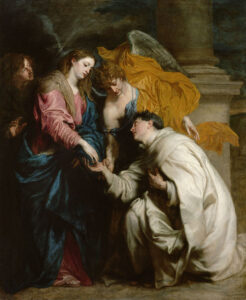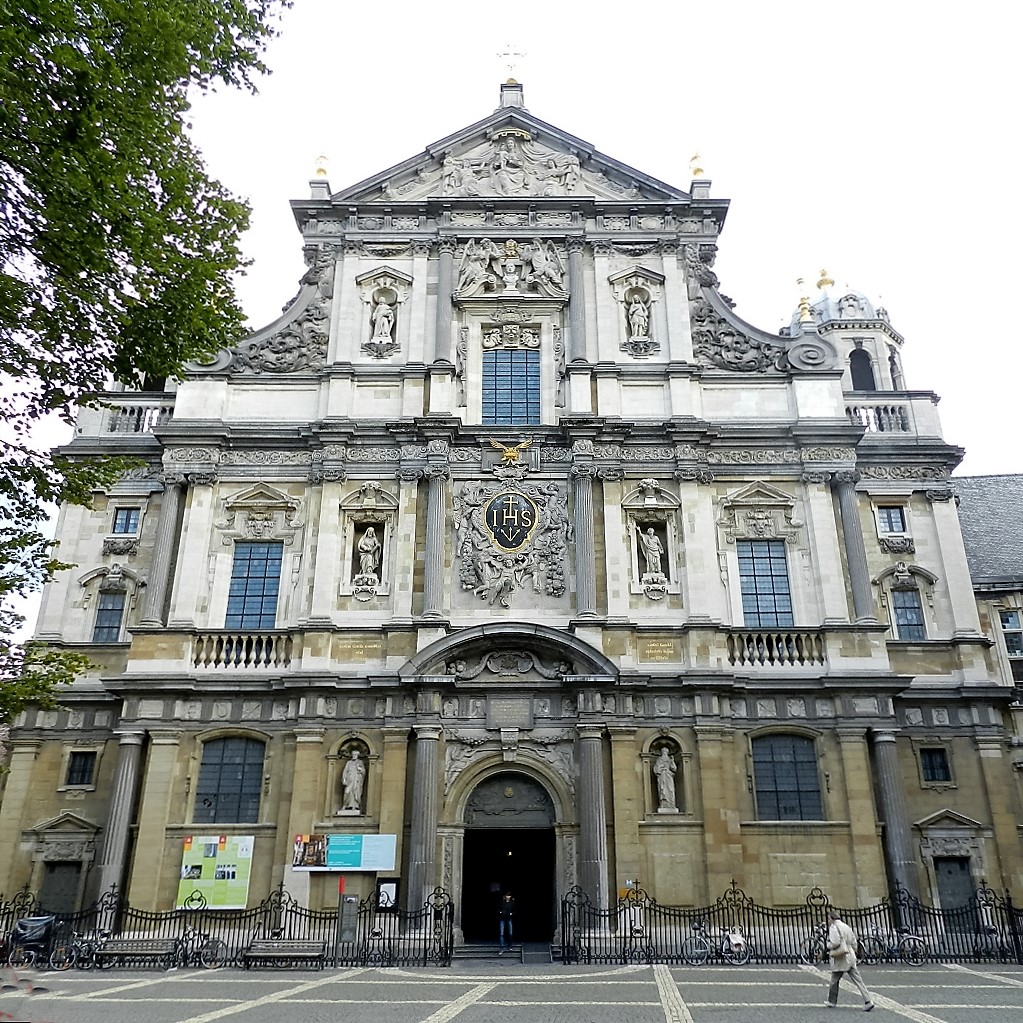The Antwerp jesuit church, a revelation.
The sodality building
Gathering around Mother Mary
The fathers of the profess house were also responsible for the Sodalities of Our Lady. In order to conduct male persons from all social classes and ages to the ideal of holiness the Society of Jesus founded fellowships of which Jesus’ mother, Mary, was the patron. Divided according to age, marital status or language the members of these sodalities gathered on Sunday mornings. The first sodalities were founded among college pupils after the town had been reconquered in 1585. It was they who took action to give mother Mary, the patron of the town, a more than life size statue on the front of the town hall: a sculpture by Philips De Vos. Such a deepening of faith, focusing on a specific group of people was quite successful among intellectuals and artists and among middle classes. This missionary work flourished extremely well, not only in number of members but also in activities and influence. The increasing membership (over 3,000), spread across some ten sodalities, forced them to have a separate wing built – at their own costs: the sodality building (1622-1623), consisting of two vast chapels for gatherings, one above the other.
The ground floor was used by grownups: either the Dutch speaking married men, or the more scholarly Latinists, including P.P. Rubens, Balthasar Moretus and a few clergymen such as canonSomeone who, together with other canons, is attached to a cathedral or collegiate church and whose main task is to ensure choral prayer. Aubertus Miraeus. Of both sections Our Lady of the Annunciation was the patron and above the altar the members could all admire a representation by their kindred spirit Rubens, whose active contribution also shows in two mandates as committee member. Later also the French speaking section (the ‘Wallons’), the foreigners who lived in Antwerp, also gathered there. Their patron was Our Lady Immaculate.

The upper chapel
A small church that is not a parish church. It may be part of a larger entity such as a hospital, school, or an alms-house, or it may stand alone.
An enclosed part of a church with its own altar.
belonged to the Dutch speaking youngsters, who could go upstairs more easily. Those who were older than 18 and unmarried were members of the Bejaerde jongmans (literally: ‘Old bachelors), with Our Lady of the Nativity as their patron. One of their most famous members was Anthony van Dyck, who in 1628 painted Our Lady with Child and SaintThis is a title that the Church bestows on a deceased person who has lived a particularly righteous and faithful life. In the Roman Catholic and Orthodox Church, saints may be venerated (not worshipped). Several saints are also martyrs. Rosalia, as well as The mystic marriage of the beatified Herman-Joseph. The fact that he charged only modest sums for these paintings, may suggest that he was more than a paper member.
It is striking that so many artists were members of these sodalities. That is why their registration here has been the most frequently quoted biographic source, after the registration list of Saint Luke’s Guild. No wonder that these gathering rooms excelled in artistic splendour
Especially the upper chapel must have been magnificent, full of rich materials and colours. A cycle of no less than 27 paintings in honour of Mother Mary embellished the ceiling. Before the Revolution French soldiers admired this chapel so much that they found it worthy to be their king’s dining hall. All this splendour perished at the abolition of the Jesuit order in 1773. This happened improperly since the sodalities had an independent status and had always paid for its construction, accommodation, decoration and maintenance themselves.
Although in their prestigious college the future leading classes were moulded, the Jesuit’s mission also aimed at the education of working youngsters. In line with Sunday schools they organized religious instruction both in town as in the surrounding countryside: catechism classes. This could only be done with the support of the sodalities. For this goal thirteen chapels were at their disposal in town. Thus, there was outreach to no less than 3,200 children in 1609. A separate sodality, the Brotherhood of Christian Teaching, with Charles Borromeo as their patron, had to promote this mission even more. Some forty middle class and noble women took care of the girls. A special category were the spiritual daughters: middle class women who aimed at Christian virtuousness, took the oath of chastity and mostly continued living in their parents’ house. For spiritual guidance, they got help from a Jesuit.
The children’s inquisitiveness was promoted by competitions, with prints, medals, rosaries and books of devotion as rewards. This culminated into a magnificent catechism feast with biblical and allegoric tableaus. In this way, it was the Jesuits who introduced the feast of the First CommunionThe consumption of consecrated bread and wine. Usually this is limited to eating the consecrated host. (1656). Sometimes there were as many as 1,600 children making their first Communion in one year. To support these catechism classes the Antwerp Jesuits published books of catechism. This initiative gave rise to the Catechism of Malines (1623) under the guidance of FatherPriest who is a member of a religious order. Willem de Pretere.

